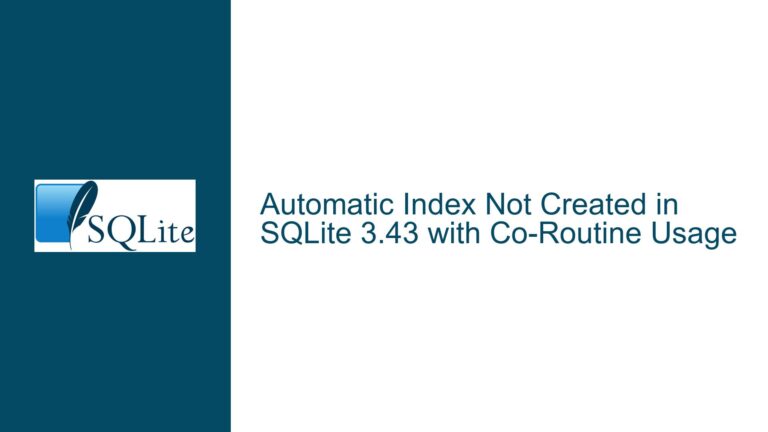Query Planner Stability with SQLITE_ENABLE_STAT4 and QPSG Configuration
Query Planner Stability Under SQLITE_ENABLE_STAT4 and QPSG Runtime Configuration
When working with SQLite, the stability of the query planner is a critical factor in ensuring predictable and efficient query execution. The query planner is responsible for determining the most efficient way to execute a given SQL statement, and its decisions are influenced by various factors, including database statistics, schema design, and runtime configurations. One of the key features that can impact query planner stability is the SQLITE_ENABLE_STAT4 compile-time option, which enhances the quality of the statistics collected by the ANALYZE command. Additionally, the Query Planner Stability Guarantee (QPSG) is a runtime configuration that can be enabled to ensure that the query planner produces consistent plans under certain conditions.
However, the interaction between SQLITE_ENABLE_STAT4 and QPSG is not always straightforward. When SQLite is compiled with SQLITE_ENABLE_STAT4 but without SQLITE_ENABLE_QPSG, and QPSG is subsequently enabled at runtime using the SQLITE_DBCONFIG_ENABLE_QPSG option, the behavior of the query planner can become unpredictable. Specifically, the ANALYZE command, which is used to gather statistics about the distribution of data in the database, can lead to changes in the query plan, even when QPSG is enabled. This can result in performance degradation or unexpected behavior in applications that rely on consistent query execution plans.
The core issue revolves around the stability of the query planner when SQLITE_ENABLE_STAT4 is enabled and QPSG is configured at runtime. The question is whether QPSG remains disabled, or if it is enabled but with a higher likelihood of query plan changes due to the enhanced statistics provided by SQLITE_ENABLE_STAT4. Understanding this interaction is crucial for database developers who need to ensure consistent performance in their applications.
Interplay Between SQLITE_ENABLE_STAT4 and QPSG Runtime Configuration
The behavior of the query planner in SQLite is influenced by both compile-time options and runtime configurations. SQLITE_ENABLE_STAT4 is a compile-time option that enhances the statistics collected by the ANALYZE command. These statistics provide the query planner with more detailed information about the distribution of data in the database, which can lead to more accurate and efficient query plans. However, the enhanced statistics also mean that the query planner has more information to work with, which can result in more frequent changes to the query plan when the statistics are updated.
On the other hand, the Query Planner Stability Guarantee (QPSG) is a runtime configuration that can be enabled using the SQLITE_DBCONFIG_ENABLE_QPSG option. When QPSG is enabled, the query planner is designed to produce consistent query plans as long as certain conditions are met. These conditions include keeping the database schema unchanged and not re-running the ANALYZE command. The goal of QPSG is to ensure that the query planner does not change its plan in response to minor variations in the database or query parameters, which can lead to unpredictable performance.
However, when SQLITE_ENABLE_STAT4 is enabled, the enhanced statistics collected by the ANALYZE command can lead to more frequent changes in the query plan, even when QPSG is enabled. This is because the query planner has access to more detailed information about the data distribution, which can cause it to reevaluate its plan more frequently. As a result, the stability of the query planner is compromised, and the benefits of QPSG are diminished.
In addition, the interaction between SQLITE_ENABLE_STAT4 and QPSG is further complicated by the fact that QPSG is designed to work with a fixed set of query parameters. When SQLITE_ENABLE_STAT4 is enabled, the query planner may take into account the specific values of query parameters when generating a plan. This means that even small changes in the query parameters can lead to changes in the query plan, further reducing the stability of the planner.
Ensuring Query Planner Stability with SQLITE_ENABLE_STAT4 and QPSG
To ensure query planner stability when using SQLITE_ENABLE_STAT4 and QPSG, it is important to carefully manage the conditions under which the query planner operates. The following steps can help mitigate the risks associated with the interaction between these two features:
Avoid Re-running ANALYZE: One of the key conditions for maintaining query planner stability with QPSG is to avoid re-running the ANALYZE command. When SQLITE_ENABLE_STAT4 is enabled, the enhanced statistics collected by ANALYZE can lead to more frequent changes in the query plan. To prevent this, it is important to run ANALYZE only when necessary, such as after significant changes to the database schema or data distribution. Once ANALYZE has been run, it should not be re-run unless absolutely necessary.
Keep the Database Schema Unchanged: Another condition for maintaining query planner stability with QPSG is to keep the database schema unchanged. Changes to the schema, such as adding or removing indexes, can lead to changes in the query plan. To ensure stability, it is important to finalize the database schema before enabling QPSG and to avoid making changes to the schema after QPSG has been enabled.
Use Fixed Query Parameters: When SQLITE_ENABLE_STAT4 is enabled, the query planner may take into account the specific values of query parameters when generating a plan. To ensure stability, it is important to use fixed query parameters whenever possible. This means avoiding the use of dynamic query parameters that can change frequently, as this can lead to changes in the query plan.
Monitor Query Performance: Even with the above precautions, it is important to monitor query performance to ensure that the query planner is producing efficient and consistent plans. This can be done by regularly reviewing the execution plans of critical queries and comparing them over time. If significant changes in the query plan are observed, it may be necessary to re-evaluate the conditions under which QPSG is enabled or to consider alternative strategies for ensuring query planner stability.
Consider Alternative Compile-Time Options: In some cases, it may be necessary to consider alternative compile-time options to achieve the desired level of query planner stability. For example, if the enhanced statistics provided by SQLITE_ENABLE_STAT4 are not necessary for a particular application, it may be possible to disable this option and rely on the default statistics collected by SQLite. This can help reduce the likelihood of query plan changes and improve the stability of the query planner.
Implement Database Backups: Finally, it is important to implement regular database backups to protect against data loss or corruption. While this does not directly impact query planner stability, it is an important best practice that can help ensure the overall reliability and integrity of the database.
By following these steps, it is possible to achieve a balance between the enhanced statistics provided by SQLITE_ENABLE_STAT4 and the stability guarantees offered by QPSG. This can help ensure that the query planner produces efficient and consistent plans, even in complex and dynamic environments.
Conclusion
The interaction between SQLITE_ENABLE_STAT4 and QPSG in SQLite is a complex issue that requires careful management to ensure query planner stability. While SQLITE_ENABLE_STAT4 provides enhanced statistics that can lead to more efficient query plans, it can also increase the likelihood of query plan changes, even when QPSG is enabled. To mitigate this risk, it is important to avoid re-running ANALYZE, keep the database schema unchanged, use fixed query parameters, monitor query performance, consider alternative compile-time options, and implement regular database backups. By following these best practices, database developers can achieve the desired level of query planner stability and ensure consistent performance in their applications.






